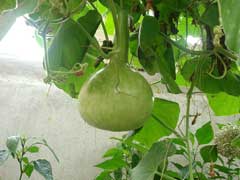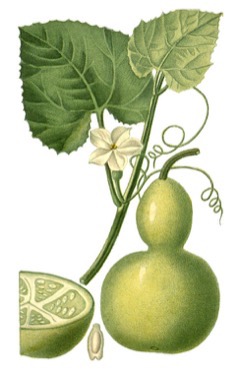 |
|
http://www.edibleplants.org |
 |
| http://www.edibleplants.org |
Translate this page:
Summary
Physical Characteristics

 Lagenaria siceraria is a ANNUAL CLIMBER growing to 9 m (29ft 6in) at a fast rate.
Lagenaria siceraria is a ANNUAL CLIMBER growing to 9 m (29ft 6in) at a fast rate.
See above for USDA hardiness. It is hardy to UK zone 10 and is frost tender. It is in flower from August to September. The species is monoecious (individual flowers are either male or female, but both sexes can be found on the same plant) and is pollinated by Insects.
Suitable for: light (sandy), medium (loamy) and heavy (clay) soils and prefers well-drained soil. Suitable pH: mildly acid, neutral and basic (mildly alkaline) soils. It cannot grow in the shade. It prefers moist soil.
UK Hardiness Map
US Hardiness Map
Synonyms
L. vulgaris.
Plant Habitats
Cultivated Beds;
Edible Uses
Edible Parts: Fruit Leaves Oil Seed Shoots
Edible Uses: Condiment Oil
Immature fruit - cooked and used as a vegetable[2, 27, 200]. They can be boiled, steamed, fried, used in curries or made into fritters[183]. Of variable quality, but some of the selected cultivars from India and China are of very good quality, equivalent to good summer squashes[183]. The pulp around the seed is purgative and should not be eaten[46]. The fruit can be dried for later use[86]. Leaves and young shoots - cooked and used as a potherb[178, 183]. Seed - cooked. Rich in oil, it is added to soups etc[183]. A vegetable curd, similar to tofu, can be made from the seed[183]. An edible oil is obtained from the seed. It is used for cooking[177, 183]. Yields of up to 45% have been obtained[240].
References More on Edible Uses
Medicinal Uses
Plants For A Future can not take any responsibility for any adverse effects from the use of plants. Always seek advice from a professional before using a plant medicinally.
Antibiotic Antidote Diuretic Emetic Febrifuge Lithontripic Odontalgic Odontalgic
Poultice Purgative Refrigerant Skin Stomachic Vermifuge
The pulp around the seed is emetic and purgative[46, 178, 272]. A poultice of the crushed leaves has been applied to the head to treat headaches[257]. The flowers are an antidote to poison[218]. The stem bark and the rind of the fruit are diuretic[218]. The fruit is antilithic, diuretic, emetic and refrigerant[178, 218]. The juice of the fruit is used in the treatment of stomach acidity, indigestion and ulcers[272]. The seed is vermifuge[218]. A poultice of the boiled seeds has been used in the treatment of boils[257]. Taken with Achyranthes spp the seed is used to treat aching teeth and gums, boils etc[218]. Extracts of the plant have shown antibiotic activity[218]. In many parts of China 3 grams per day of this species (the report does not say what part of the plant) has been used as a single treatment for diabetes mellitus[218].
References More on Medicinal Uses
The Bookshop: Edible Plant Books
Our Latest books on Perennial Plants For Food Forests and Permaculture Gardens in paperback or digital formats.

Edible Tropical Plants
Food Forest Plants for Hotter Conditions: 250+ Plants For Tropical Food Forests & Permaculture Gardens.
More

Edible Temperate Plants
Plants for Your Food Forest: 500 Plants for Temperate Food Forests & Permaculture Gardens.
More

More Books
PFAF have eight books available in paperback and digital formats. Browse the shop for more information.
Shop Now
Other Uses
Bottles Containers Musical Oil
The shell of well-ripened fruits is very hard and can be used for many purposes such as bottles, bowls, musical instruments etc. There are many different shapes of fruits from the various different varieties[1, 27, 46, 61, 86, 97].
Special Uses
Food Forest Scented Plants
References More on Other Uses
Cultivation details
Prefers a well-drained moist good rich circumneutral soil[1, 27, 86, 200]. Requires plenty of moisture in the growing season[1]. Prefers a warm sunny position sheltered from the wind[86]. The bottle gourd is widely cultivated in the tropics and sub-tropics for its edible fruit and for the hard wooden shell of the fruit that can be used as containers, musical instruments etc[206], there are many named varieties with different shaped and sized fruits[86, 183, 206]. The variety 'Cougourda' is said to be the best for eating[132]. Forms with wooden shells tend not to have an edible flesh[206]. The plants are frost-tender annuals, they grow very rapidly and their stems can reach a length of 9 metres in the summer[86]. A warm summer is required for good production of the fruit[86]. British summers are often too cool for this species and obtaining a crop from outdoor-grown plants in this country is somewhat problematical. The best chance is by starting the plants off early in a warm greenhouse, growing them on fast and then planting them out as soon as possible but making sure that they are not checked by cold weather. Hand pollination of the fruits can increase fruit set[206]. A climbing plant, attaching itself to supports by means of tendrils that grow out of the leaf axils[206]. It can be used as a fast-growing summer screen. The leaves have a strong musky scent that some people find repulsive[206]. The plant is remarkably disease and pest-free, this might be connected to the smell of the leaves[206].
References Carbon Farming Information and Carbon Sequestration Information
Temperature Converter
Type a value in the Celsius field to convert the value to Fahrenheit:
Fahrenheit:
The PFAF Bookshop
Plants For A Future have a number of books available in paperback and digital form. Book titles include Edible Plants, Edible Perennials, Edible Trees,Edible Shrubs, Woodland Gardening, and Temperate Food Forest Plants. Our new book is Food Forest Plants For Hotter Conditions (Tropical and Sub-Tropical).
Shop Now
Plant Propagation
Seed - sow spring in a greenhouse in a rich soil, putting 2 - 3 seeds in a pot and thinning to the strongest plant. Grow on fast and plant out as soon as possible after the last expected frosts, giving some protection until the plants are established and growing well. The seed germinates best at 25°c[86]. Soaking the seeds for 12 hours in warm water prior to sowing can hasten germination[86]. Discard any seeds that have not germinated after 10 days, the plants they produce will not be vigorous enough to succeed outdoors in Britain[86].
Other Names
If available other names are mentioned here
Bottle Gourd, Alabu, Bak, Bau, Bhopala, Bogalau, Cabaca, Calabash gourd, Calabaza, Core, Crockneck gourd, Didi, Diya labu, Doodhi, Dudhi, Dudhiva, Dudhya, Ekiryo, Eparra, Fahandu, Footi, Ghia, Ghiba, Ghiya, Halagumbala, Hu lu gua, Ikhomane, Kaddu, Kalabas, Khil, Klook, Kwa-kwa, Labu air, Lami-core, Lau, Lauka, Lauki, Louki, Milau, Mirandjo-lo, Naam tao, Omparsa, Opo, Orde, Pucuo, Shorakkai, Sorekayi, Sorrakaya, Tearau, Trumpet Gourd, Tumada, Tumri, Um, Undugue, Upo, Vago, White-flower gourd, Yuugao,
Native Range
AFRICA: Zimbabwe
Weed Potential
Right plant wrong place. We are currently updating this section.
Please note that a plant may be invasive in one area but may not in your area so it's worth checking.
Conservation Status
IUCN Red List of Threatened Plants Status : This taxon has not yet been assessed

Growth: S = slow M = medium F = fast. Soil: L = light (sandy) M = medium H = heavy (clay). pH: A = acid N = neutral B = basic (alkaline). Shade: F = full shade S = semi-shade N = no shade. Moisture: D = dry M = Moist We = wet Wa = water.
Now available:
Food Forest Plants for Mediterranean Conditions
350+ Perennial Plants For Mediterranean and Drier Food Forests and Permaculture Gardens.
[Paperback and eBook]
This is the third in Plants For A Future's series of plant guides for food forests tailored to
specific climate zones. Following volumes on temperate and tropical ecosystems, this book focuses
on species suited to Mediterranean conditions—regions with hot, dry summers and cool, wet winters,
often facing the added challenge of climate change.
Read More
Expert comment
Author
(Molina.)Standl.
Botanical References
200
Links / References
For a list of references used on this page please go here
A special thanks to Ken Fern for some of the information used on this page.
Readers comment